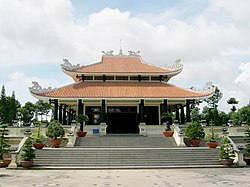This article needs additional citations for verification .(November 2021) |
An Giang | |
|---|---|
Bà Chúa Xứ Temple of Sam Mountain, Maitreya Buddha statue sitting on Cấm Mountain in Tịnh Biên, Temple of late President Tôn Đức Thắng, Mausoleum of Thoại Ngọc Hầu, Tomb of Ba Chúc, Island of Phú Quốc | |
 Location of An Giang within Vietnam | |
 | |
| Coordinates: 10°30′N105°10′E / 10.500°N 105.167°E | |
| Country | |
| Region | Mekong Delta |
| Capital of Province | Long Xuyên City |
| Government | |
| • People's Council Chair | Lê Văn Nưng |
| • People's Committee Chair | Hồ Văn Mừng [1] |
| Area | |
• Total | 9,888.91 km2 (3,818.13 sq mi) |
| Population (2025) [2] | |
• Total | 4,952,238 |
| • Density | 500.787/km2 (1,297.03/sq mi) |
| Demographics | |
| • Ethnicities | Vietnamese, Khmer, Hoa, Chăm |
| GDP [3] | |
| • Total | VND 74.297 trillion US$ 3.227 billion |
| Time zone | UTC+7 (ICT) |
| Area codes | 296 |
| ISO 3166 code | VN-44 |
| HDI (2020) | (55th) |
| Website | angiang |
An Giang is a province of Vietnam. It is located in the Mekong Delta, in the country's southwestern part.
Contents
- Geography
- Etymology
- Administrative divisions
- Demographics
- Transport
- Notable people
- See also
- References
- External links
On June 12, 2025, the National Assembly passed Resolution No. 202/2025/QH15, [5] which took effect the same day, merging Kiên Giang Province into An Giang Province.








